
Classic Airframes 1/48 Sea Hornet
|
KIT # |
? |
|
PRICE: |
$54.95 |
|
DECALS: |
Two Aircraft |
|
REVIEWER: |
|
|
NOTES: |
Multi-media kit |

|
HISTORY |
The Fleet Air Arm was as impressed with the deHavilland Hornet design as the RAF. The Admiralty, however, waited until the first prototype had flown before - in November 1944 - Specification N.5/44 was released, written around a navalized version of the single-seat fighter. DeHavilland had foreseen this development from the outset, and the third, fifth and twentieth production Hornet F.Mk.1s were developed as shipboard trials aircraft, as the Sea Hornet. The first two were merely "hooked Hornets", equipped with an A-frame arrester hook below the rear fuselage, while the third, PX219, was fully navalized by Heston Aircraft, with Lockheed power-operated upward-folding outer wings, tail-down accelerator points, and the replacement of the rubber-in-compression RAF main gear with Airdraulic legs. The changes added 550 pounds to the overall aircraft weight, though this had little effect on performance, with climb unchanged and maximum speed reduced by 4 knots as compared with the land-based Hornet.
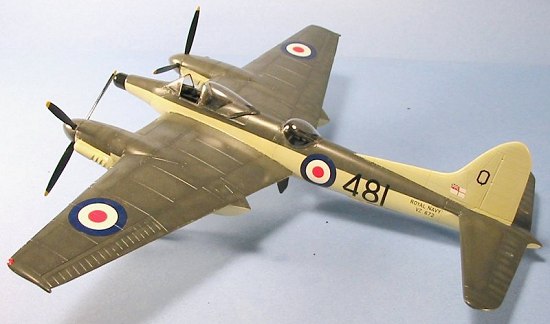 The first semi-navalized
Sea Hornet was delivered April 19, 1945. Two days after VE-day it was first
flown by LCDR Eric Brown. For a naval aircraft, the cockpit was perfectly
situated, with outstanding vision for landing. Brown was able to demonstrate
within a few days that the Hornet was nearly as good a performer in an
aerobatic routine on one engine as it was on two; when the Royal Navy toured
the United States in 1948, three Sea Hornet F Mk.20s would be part of the
tour, and would provide a breathtaking aerobatics routine by turning off one,
then the other, of the engines and performing a complete engine-out routine on
either one during the New York International Air Exposition.
The first semi-navalized
Sea Hornet was delivered April 19, 1945. Two days after VE-day it was first
flown by LCDR Eric Brown. For a naval aircraft, the cockpit was perfectly
situated, with outstanding vision for landing. Brown was able to demonstrate
within a few days that the Hornet was nearly as good a performer in an
aerobatic routine on one engine as it was on two; when the Royal Navy toured
the United States in 1948, three Sea Hornet F Mk.20s would be part of the
tour, and would provide a breathtaking aerobatics routine by turning off one,
then the other, of the engines and performing a complete engine-out routine on
either one during the New York International Air Exposition.
Brown first took the Sea Hornet aboard HMS "Ocean" on August 10, 1945. This first Sea Hornet had several control problems involving operation of the control surfaces in the Naval landing configuration, all of which were quickly dealt with by deHavilland on subsequent aircraft.
Despite the end of the war, the FAA continued further development of the Sea Hornet, with the first F Mk.20 appearing on August 13 1946 as a single-seat long-range escort fighter. The top speed of 400 knots made it one of the fastest piston-engine carrier fighters to operate in the FAA, and was to be exceeded only by the Hawker Sea Fury. 801 Squadron, formed June 1, 1947, was to be the only operational squadron to use the F Mk.20, taking their aircraft aboard HMS "Implacable" in 1949. 801 used their Sea Hornets on "Implacable" until early 1951, transferring to HMS "Indomitable" until June 1951, when the squadron was stood down to transfer to the Sea Fury.
The NF Mk.21 Appears:
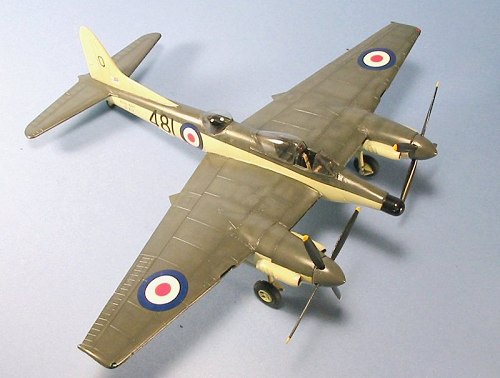 After the capability
of the Sea Hornet had been successfully displayed aboard HMS "Ocean",
Specification N.21/45 was issued, covering the development of a night-fighting
version of the Sea Hornet. The second trials aircraft, PX230, was delivered
to Heston Aircraft for conversion and emerged on July 9 1946 as the prototype
NF Mk.21 Sea Hornet. It featured an ASH AI scanner in an extended nose radome
that gave the aircraft a decided "mosquito" look, large flame-damping
exhausts, a longer-span tailplane as used on the F Mk.20 Sea Hornet and F.Mk.3
Hornet, and a second cockpit for the radar operator with entry hatch on the
fuselage underside, under a jettisonable blister aft of the wing.
Surprisingly, the drag produced by these changes was very small, and the
performance of the NF Mk.21 was virtually unchanged from the single-seater,
other than a loss of 3 more knots in maximum speed.
After the capability
of the Sea Hornet had been successfully displayed aboard HMS "Ocean",
Specification N.21/45 was issued, covering the development of a night-fighting
version of the Sea Hornet. The second trials aircraft, PX230, was delivered
to Heston Aircraft for conversion and emerged on July 9 1946 as the prototype
NF Mk.21 Sea Hornet. It featured an ASH AI scanner in an extended nose radome
that gave the aircraft a decided "mosquito" look, large flame-damping
exhausts, a longer-span tailplane as used on the F Mk.20 Sea Hornet and F.Mk.3
Hornet, and a second cockpit for the radar operator with entry hatch on the
fuselage underside, under a jettisonable blister aft of the wing.
Surprisingly, the drag produced by these changes was very small, and the
performance of the NF Mk.21 was virtually unchanged from the single-seater,
other than a loss of 3 more knots in maximum speed.
Deck landing trials began October 25, 1948, and were so successful that night landing trials followed immediately. The first production NF Mk. 21 appeared on March 24, 1948; 79 Sea Hornet NF Mk.21s were delivered by June 12, 1951.
The night fighting Sea Hornet would also equip only one squadron, that being 809, which was commissioned in January 1949. The unit served aboard HMS "Vengeance" in 1950-51, and was based at Hal Far, Malta, until June 1954 when 809 was disbanded to transfer to the Sea Venom.
|
THE KIT |
The Sea Hornet kit is similar to the previously-reviewed Hornet kit, with the
addition of resin parts for the radar nose, the
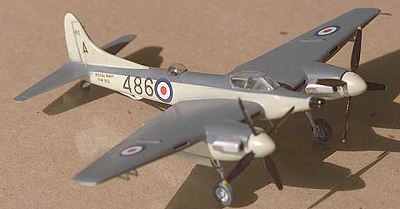 second
cockpit, resin flame-damping exhausts, and the blister hood for the second
cockpit of the NF Mk.21. The modeler who wishes to build the Sea Hornet
F. Mk.20 will not need these parts. Decals are provided for a Sea Hornet
F. Mk. 20 based at Hal Far Malta in 1951, and a Sea Hornet NF Mk.21 of 809
Squadron aboard HMS "Vengeance," also in 1951. (Editor's Note: I do believe
that Classic Airframes forgot to add the wing fold hinge covers. You may also
want to add the fin mounted IFF antennas which were mounted on some planes.
You can see these items in the picture of my old Frog 1/72 Hornet [to left]
which I modified with a C-scale conversion set about 15-20 years ago)
second
cockpit, resin flame-damping exhausts, and the blister hood for the second
cockpit of the NF Mk.21. The modeler who wishes to build the Sea Hornet
F. Mk.20 will not need these parts. Decals are provided for a Sea Hornet
F. Mk. 20 based at Hal Far Malta in 1951, and a Sea Hornet NF Mk.21 of 809
Squadron aboard HMS "Vengeance," also in 1951. (Editor's Note: I do believe
that Classic Airframes forgot to add the wing fold hinge covers. You may also
want to add the fin mounted IFF antennas which were mounted on some planes.
You can see these items in the picture of my old Frog 1/72 Hornet [to left]
which I modified with a C-scale conversion set about 15-20 years ago)
|
CONSTRUCTION |
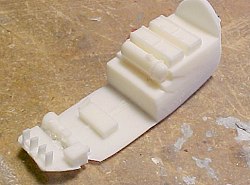
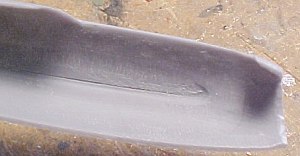 Having built an F
Mk. 3 Hornet, I knew that the main thing to do was to insure good fit of the
cockpits inside the fuselage. To accomplish this, I used my Dremel to
drastically thin the fuselage sides around the cockpit areas, then did a lot
of test fitting and dremeling to the forward cockpit resin base, to get an
easy fit. Once this was done, I cut off the fuselage nose and test-fitted the
resin radome replacement.
Having built an F
Mk. 3 Hornet, I knew that the main thing to do was to insure good fit of the
cockpits inside the fuselage. To accomplish this, I used my Dremel to
drastically thin the fuselage sides around the cockpit areas, then did a lot
of test fitting and dremeling to the forward cockpit resin base, to get an
easy fit. Once this was done, I cut off the fuselage nose and test-fitted the
resin radome replacement.
 The two cockpits
were easily assembled after I had done this modification to the kit, and were
painted flat black. I dry-brushed them with Testors Metalizer Aluminum to
bring out detail, and equipped the pilot's cockpit with seatbelts made from
lead foil. I did not have to do this for the observer's cockpit, since I had
decided to open the lower hatch, which meant that the observer's seat was in
the folded position that allowed entry to the very-tight cockpit; I am sure
only very small men were assigned as radar operators with the Sea Hornet.
The two cockpits
were easily assembled after I had done this modification to the kit, and were
painted flat black. I dry-brushed them with Testors Metalizer Aluminum to
bring out detail, and equipped the pilot's cockpit with seatbelts made from
lead foil. I did not have to do this for the observer's cockpit, since I had
decided to open the lower hatch, which meant that the observer's seat was in
the folded position that allowed entry to the very-tight cockpit; I am sure
only very small men were assigned as radar operators with the Sea Hornet.
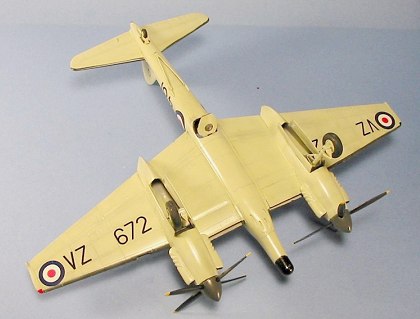 Beyond these
differences, assembly of the rest of the model was no different from what I
had done with the F Mk.3, other than to use the parts for the A-frame tail
hook.
Beyond these
differences, assembly of the rest of the model was no different from what I
had done with the F Mk.3, other than to use the parts for the A-frame tail
hook.
I had hoped to use Roy Sutherland's resin aftermarket set for this kit, which would have included drop tanks, more accurate wheels, and a wing-fold. Unfortunately, the set is not available due to the fact Roy has a "real job" at present that is taking all of his time for the foreseeable future. He has assured me that the set will be released as soon as he finds the time to produce it, but that will not be for several months.
The pilot's canopy was modified as I had done for the F Mk.3, changing the shape of the rear section. This time, I sanded and carefully cut around the windscreen, and was able to fit it more correctly with the entire screen going over the instrument coaming. There was quite a bit of trimming and test-fitting involved in getting the observer's bubble to correctly fit the cockpit area after that had been opened in the rear fuselage. I noticed when I opened up the lower entry hatch that the opening is not exactly the same shape as the separately-molded hatch; however, this is not that apparent when the hatch is posed in the open position.
|
CAMOUFLAGE & MARKINGS |
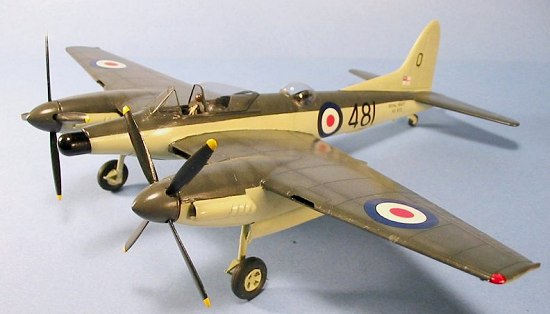 Painting:
Painting:
After pre-shading the model with flat black, I painted it in the FAA post-war scheme of Sky and Dark Sea Grey, using Gunze-Sangyo's "Sky" color, which is more yellow and more accurate for the post-war FAA color than Tamiya's "Sky" - which is the more correct color for World War II aircraft. I used Tamiya "Dark Grey" for the Dark Sea Grey color. When all was dry, I gave the model two coats of Future.
Decals:
The kit decals are printed by Micro-Scale and are accurate in color and size. They went down with no problem under a coat of Micro-Sol.
|
FINAL CONSTRUCTION |
The photos I have seen of the NF Mk.21 show a well-maintained, clean airplane. I did not apply any exhaust staining, and - since it is a wooden airplane - there was no "scuffing" or "chipping" to do to the airframe. I attached the pilot's canopy in the open position, and attached the open observer's cockpit hatch.
|
CONCLUSIONS |
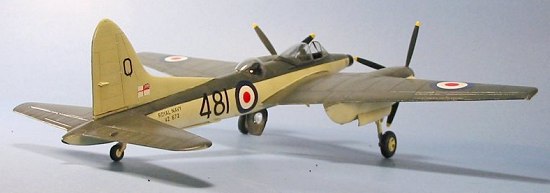 I have wanted a
model of this airplane ever since I saw a photograph of it as a child in one
of William Green's books about British aircraft of the early 1950s, and the
model does not disappoint. This Sea Hornet looks more like a "mosquito" than
any Mosquito ever did, with its long and narrow proboscis of a radome nose.
It is definitely not as beautiful as the single-seater, but is still a very
dramatic-looking model. It looks good sitting next to my Sea Fury F.B.11,
Seafire F.R.47, and Firefly F.R.4.
I have wanted a
model of this airplane ever since I saw a photograph of it as a child in one
of William Green's books about British aircraft of the early 1950s, and the
model does not disappoint. This Sea Hornet looks more like a "mosquito" than
any Mosquito ever did, with its long and narrow proboscis of a radome nose.
It is definitely not as beautiful as the single-seater, but is still a very
dramatic-looking model. It looks good sitting next to my Sea Fury F.B.11,
Seafire F.R.47, and Firefly F.R.4.
March 2003.
Kit compliments of my wallet.
Copyright ModelingMadness.com. All rights reserved. No reproduction in any form without express permission from the editor.
If you would like your product reviewed fairly and fairly quickly, please contact the editor or see other details in the Note to Contributors.